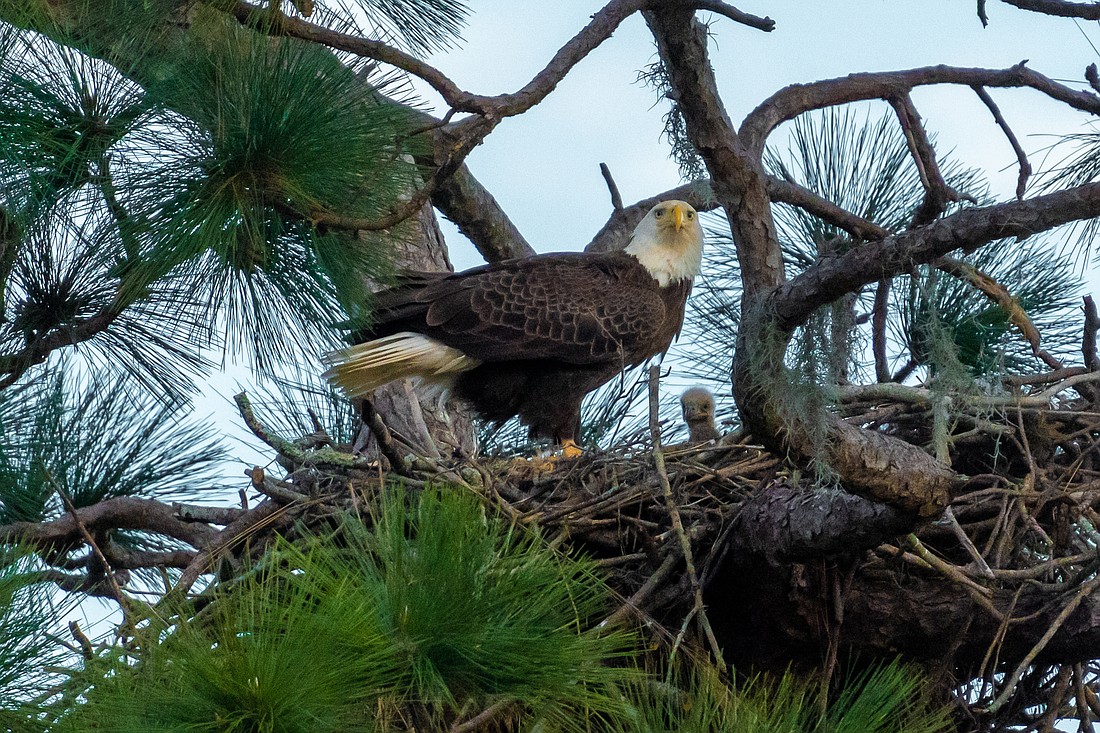- April 26, 2024
-
-
Loading

Loading

The corner of East Crown Point Road and Plant Street in Winter Garden is home to a popular family.
However, the family doesn’t live in a typical home, but instead, a nest.
Bald eagle nest OR066 has been home for an eagle couple for more than 12 years, according to the Florida Fish and Wildlife Conservation Commission.
Now, that home may be in danger.
Over the New Year weekend, Winter Garden resident Diane Melesio noticed a message board placed directly in front of the active Bald Eagle’s nest. The construction said it would start on Tuesday, Jan. 4.
Melesio said the nest is popular for locals, because of its accessibility and visibility. She keeps a special eye on the nest both as a photographer and a member of the Audubon EagleWatch program at the Audubon Center for Birds of Prey.
“The nest has been there for years and there are quite a few of us local residents that like to keep an eye on it,” Melesio said.
The construction in the area is set to include widening, milling and resurfacing of the mainlane expressway and ramps, as well as a reconfiguring of the Plant Street and State Road 429 Interchange, landscaping and associated infrastructure.
Melesio said her particular concern rests with the newly born eaglet, who is less than a month old.
“The next two months are really important for the baby because of feeding that occurs all day, in the same hours of construction, and the fledging because when they start flying they aren’t real coordinated,” Melesio said. “They’re clumsy and if a loud noise startles them they could fall out of the nest.”
According to the U.S. Fish and Wildlife Service, the construction company with the Central Florida Expressway Authority does have a permit for nest disturbance, with specific guidelines for the planned work near the nest at various distances.
The construction permit shows the construction will take place with the nest being impacted within the 660-foot radius. However, the construction cannot take place closer than 173 feet from the nest at any time of year.
According to the permit, the construction crew is expected to create an eagle nest buffer to delineate the 173-foot buffer to prevent personnel or heavy equipment entering the area.
The crew must refrain from excessive or sudden loud noises, minimize the need for “reverse” indicator horns and provide signage to indicate the need for quiet.
Melesio, who is also in construction as a project manager with Harris Rebar, said although she knows the crew may do its best, the guidelines may not be enough.
“I understand the crew has a job to do, but as someone in construction, I just don’t know if all of this is possible while still getting the job done,” she said.
Within the 173 feet boundary of the nest, exterior construction, heavy landscaping and associated activities are prohibited, access roadways within the project limits are to be kept free of carcasses to minimize the attraction of wildlife, and lights are to be down-shielded so as to not shine directly on the nest.
Shawnlei Breeding, program manager of the Audubon EagleWatch program at the Audubon Center for Birds of Prey, said situations like this can be common, because the construction companies may not be aware of the nests.
She said the project has taken the appropriate steps of applying with USFWS for a Federal Nest Disturbance permit.
If the nest does fail because of the work, Breeding said the company would be covered by the permit.
“There’s the understanding that they are doing their best not to disturb the nest but it may disturb the nest,” Breeding said. “Everyone’s trying to do the right thing, and nobody wants to see the nest fail but the work project does need to be done.”
Breeding said that like humans, eagles have different living preferences.
“A lot of the eagles that are settling in urban areas are showing their tolerance for being around humans and interacting in certain capacities with forces such as traffic, pollution and construction,” Breeding said. “These are also good parents and they are experienced parents.”
Breeding said the eagle’s resilience is one of the things that most inspires her about the species.
“Most of the time the eagles do go on and nest successfully,” she said. “Their drive to take care of their young and raise them is incredibly strong.”
As a biologist and a conservationist, the program manager said the eagles give her hope.
“You hear all the difficult news with species becoming extinct and environmental destruction but the bald eagles are such a great example of a species that have faced adversity and overcome it,” she said.